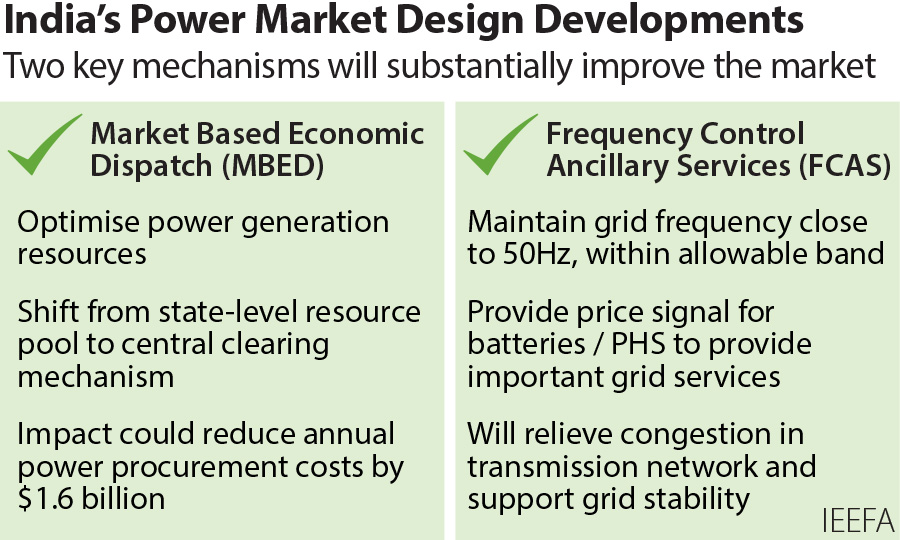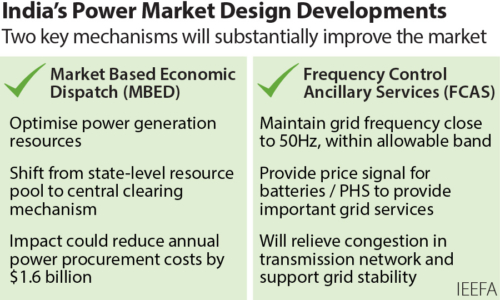IEEFA India: Proposed power market reforms could reduce renewable energy costs further

9 September 2021 (IEEFA India): Two proposed reforms to the design of India’s electricity market – a national system of market-based economic dispatch (MBED) for procuring bulk power and new regulations for Frequency Control Ancillary Services (FCAS) – are positive developments that will help pave the way for the rollout of large-scale, ultra-low cost variable renewable energy.
Both developments will improve efficiency, competition and liquidity in the power market.
A new Institute for Energy Economics and Financial Analysis (IEEFA) briefing note looks at the benefits and potential roadblocks to implementation of these key reforms and argues that they are important steps towards transforming India’s power sector into a low-emissions, low-cost and profitable part of the economy.
“Both developments will improve efficiency, competition and liquidity in the power market,” says the note’s author Kashish Shah, Research Analyst at IEEFA.

Under the Ministry of Power’s proposed MBED mechanism, power would be dispatched through a central pool instead of at state level, helping to optimise India’s power generation resources.
Efficient price discovery would reduce power procurement costs by Rs12,000 crore (US$1.6bn) annually, according to government estimates, leading to an improvement in the financial situation of the state-owned distribution companies (discoms).
This would, in effect, create a virtuous circle, reducing delays in discoms’ payments to generators and adding protection to renewable energy power purchase agreements (PPAs), says Shah.
“Improved bankability of PPAs can potentially lower the cost of capital which will in turn reduce the cost of renewable energy and make the market even more conducive to renewables.”
Cheaper plants would be dispatched first which would raise the stranded asset risk for expensive coal plants.
Shah also points out that as the market becomes more competitive, cheaper plants would be dispatched first which would raise the stranded asset risk for expensive thermal power plants.
The note also discusses the second progressive market development: the Central Electricity Regulatory Commission’s (CERC) draft regulations for procurement, deployment and payment of ancillary services to maintain the grid frequency at 50 Hertz.
“The integration of high shares of solar and wind will require an increase in India’s reserve resources, particularly primary and secondary reserves, to manage deviations in the frequency due to the intermittency of renewable energy,” says Shah.
“Delivery of Frequency Control Ancillary Services (FCAS) will allow competitive price signalling for investment into important grid flexibility tools, such as utility-scale batteries and pumped hydropower storage.
“The development of a formal market for FCAS will provide another substantial revenue stream for utility-scale batteries and allow them to operate as an important grid management asset.”
The note says the proposed reforms need finessing and calls for the FCAS regulations to be tightened to include battery storage among Primary Response Ancillary Services.
“These reforms will lay solid foundations for a modern and competitive market necessary to transform India’s power market,” says Shah.
Read the report: Finessing India’s Power Market Design to be More Competitive
Media contact: Rosamond Hutt ([email protected]) +61 406 676 318
Author contact: Kashish Shah ([email protected])
The author is available for interviews or background briefings.
About IEEFA: The Institute for Energy Economics and Financial Analysis (IEEFA) examines issues related to energy markets, trends, and policies. The Institute’s mission is to accelerate the transition to a diverse, sustainable and profitable energy economy. (www.ieefa.org)











